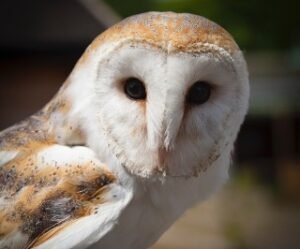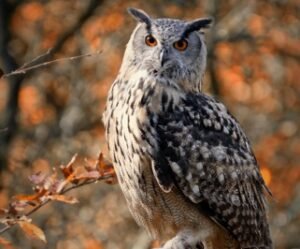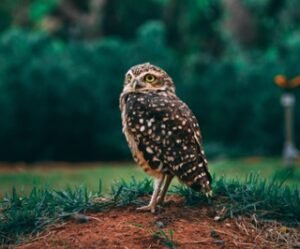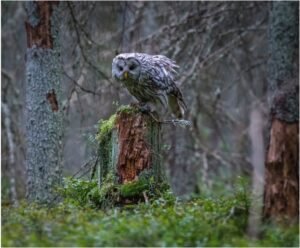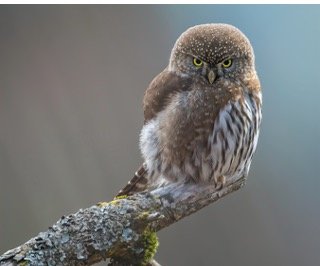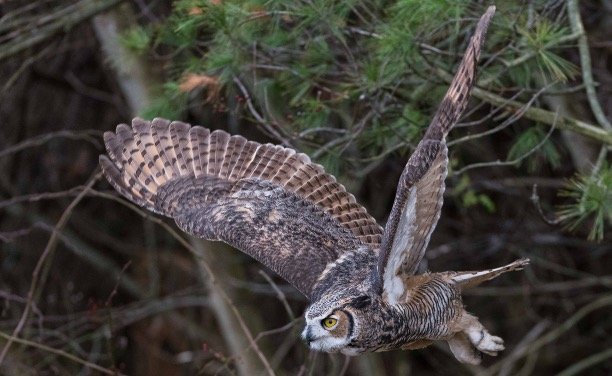
The mysterious owl is a favorite bird for many. The fact that most of us never see them due to their camouflage and nocturnal habits makes them all the more fascinating.
It can also lead you to wonder just how many different kinds of owls can be found where I live? In this article we will look at the 10 species of owls in Maryland.
Eighteen species of owls can be found in North America, ten of which occur in Maryland. Barred Owls, Barn Owls, Eastern Screech-Owls and Great-Horned Owls are commonly found throughout Maryland.
Northern Saw-Whet Owls migrate through the State in late fall and a few occasionally breed in western Maryland in the summer. Short-Eared Owls and Long-Eared Owls historically nested in Maryland, but no breeding birds have been seen in a number of years. Snowy Owls occasionally migrate through the State and can be seen along Assateague Island.

You will see all of the owl species that can be found in Maryland. However, owls can also be found in open fields, near water bodies, and even near suburban areas. Some of them are more difficult to find than others, so will you be lucky enough to find them all.
Ten Owls Species in Maryland:
- Barn Owl
- Eastern-screech Owl
- Great Horned Owl
- Snowy Owl
- Barred Owl
- Long-eared Owl
- Short-eared Owl
- Northern Saw-whet Owl
- Flammulated Owl
- Burrowing Owl
The Great Horned Owl is the largest owl in Maryland, and the Northern Saw-whet Owl is the smallest. Owls are predatory birds that hunt and consume small mammals, as well as snakes, frogs, and insects.
Owls consume their prey whole, frequently after removing the head, and regurgitate the bones and fur. For the best chance of seeing owls in Maryland, go to a wooded area at dawn or dusk. Consider high vantage points on the forest’s edge that overlook open grassland or pastures.
10 Species of Owl in Maryland
1. Barn Owl
The Barn Owl can be seen in Maryland all year, but it is not very common. This silent nocturnal bird with a white face is about the size of a crow.
- Length: 12.6-15.8 in (32-40 cm)
- Weight: 14.1-24.7 oz (400-700 g)
- Wingspan: 39.4-49.2 in (100-125 cm)
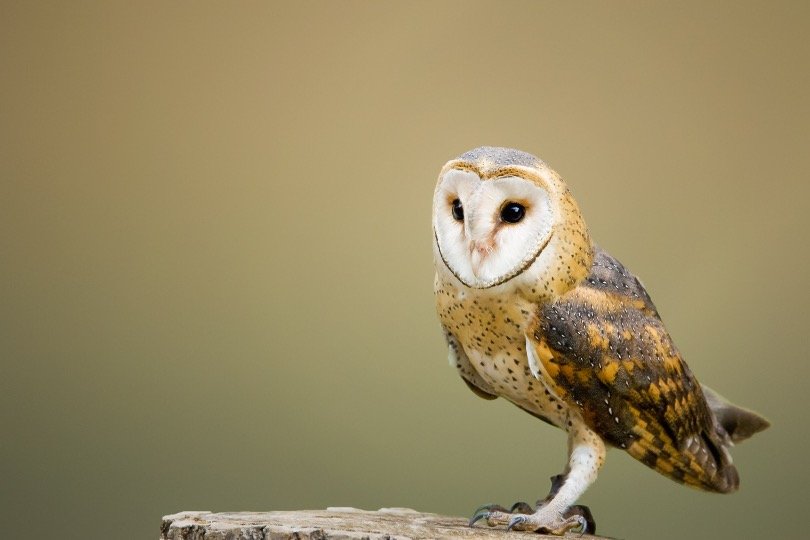
Barn owls have buff-colored backs and white faces, chest, and belly, as well as underwings. Their faces are round, and they have long, rounded wings and short tails. Females have parasite-repelling spots on their chests, and the greater the number of spots on the female’s chest, the greater the amount of contribution the male makes to the construction of the nest!
It is believed that they search for tiny rodents across open ground at night, such as fields and meadows, and that their name comes from the fact that they frequently roost in barns during the day.
15 Cutest Owls In The World
Barn owls eat their food whole and cough up pellets twice a day, according to the National Wildlife Federation. As with all animals examined, the Barn Owl hunts for prey largely by sound because it has the finest hearing of any species.
Listen Barn Owl Hoot:
Credit: Manceau Lionel, XC659876. Accessible at www.xeno-canto.org/659876.
These abilities enable them to hunt down and capture prey in full darkness, including those hiding beneath plants or in a show. They construct their nests in tree cavities, caves, and, more frequently, in barns or other abandoned or silent structures, according to the National Wildlife Federation.
The nest is formed of regurgitated pellets that have been organized into a cup by their feet and placed inside a cup. They lay between 2 and 18 white eggs throughout the course of 1 to 3 broods.
Approximately 46 species of Barn Owls may be found throughout the world, and they can be found on all six continents. Instead of hooting like other owls, they make a scratchy scream call that is difficult to understand.
2. Eastern Screech Owl
The Eastern Screech-Owl can be seen in Maryland all year and is common east of the Rockies.
- Length: 6.3-9.8 in (16-25 cm)
- Weight: 4.3-8.6 oz (121-244 g)
- Wingspan: 18.9-24.0 in (48-61 cm)

Gray and red are the colors of this short, stocky bird. A robin’s size is comparable to that of a crow, but they are more bulkier, with a large head and little neck. As a result of their camouflage patterns and spots, they are difficult to distinguish against tree bark.
When looking for the Eastern Screech-Owl, look for it in woodlands and parks, where you may be able to notice it sunning itself in a tree cavity on cold sunny days, or by the flurry of songbirds that flock to them when they discover them.
5 Simple & Proven Ways To Attract Owls To Your Yard
Another telltale sign is a collection of pellets on the ground. They can be identified by their harsh, descending whinny sound and vibrating trill. Eastern Screech-Owls prey on a wide variety of tiny animals, including birds, mammals, insects, reptiles, and amphibians.
Listen Eastern Screech Owl Hoot:
Credit: Lance A. M. Benner, XC513355. Accessible at www.xeno-canto.org/513355.
They hunt primarily at night, although they also hunt at dawn and twilight, and they are nocturnal. They typically sit on perches and wait for prey to pass by before leaping to their death from them.
Given that they are unable to excavate their own nests, the Eastern Screech-Owl typically makes use of abandoned woodpecker nests as well as other holes and cavities. Their eggs are laid on whatever trash available at the bottom of the cavity because they do not employ nesting material. They lay between 2 and 6 white eggs every time they lay an egg.
3. Great Horned Owl
Throughout the year, the Great Horned Owl can be seen in Maryland and throughout North America, including Canada. They are large owls with thick bodies and large tufts of hair on their heads that resemble ears.
- Length: 18.1-24.8 in (46-63 cm)
- Weight: 32.1-88.2 oz (910-2500 g)
- Wingspan: 39.8-57.1 in (101-145 cm)

In appearance, the Great Horned Owl is a grey-brown bird with a mottled pattern and a white patch on its throat. A deep hooting call can be heard from their nest. Their wings are large and rounded.
One of the most common owls in North America, the Great Horned Owl can be found in a range of environments, including woods, deserts, urban areas, and grasslands, among others. These ferocious hunters feed on birds and mammals that are far greater in size than they are.
6 Largest Owls In The World: Everything You Need To Know
Besides ospreys and falcons, they will also go after owls and other raptors such as peregrine falcons. Their wide diet includes small rodents such as mice or skunks, geese and hares, insects, fish, and carrion, to name a few ingredients.
Listen Great Horned Owl Hoot:
Credit: Lance A. M. Benner, XC545009. Accessible at www.xeno-canto.org/545009.
They are not picky eaters and will eat practically everything you put in front of them! When building their nests in trees, Great Horned Owls frequently re-use old nests that were previously used by another species.
Occasionally, they will line the nest with bark, leaves, downy feathers, or pellets, although they will also leave the nest unlined on occasion. They lay anything from one to four white eggs.
4. Snowy Owl
However, they are only found in Maryland during the winter months because it is the southernmost point of their winter range. They are white birds with modest amounts of black or brown patterns, yellow eyes, and are around the size of a crow in terms of size and appearance.
- Length: 20.5-27.9 in (52-71 cm)
- Weight: 56.4-104.1 oz (1600-2950 g)
- Wingspan: 49.6-57.1 in (126-145 cm)
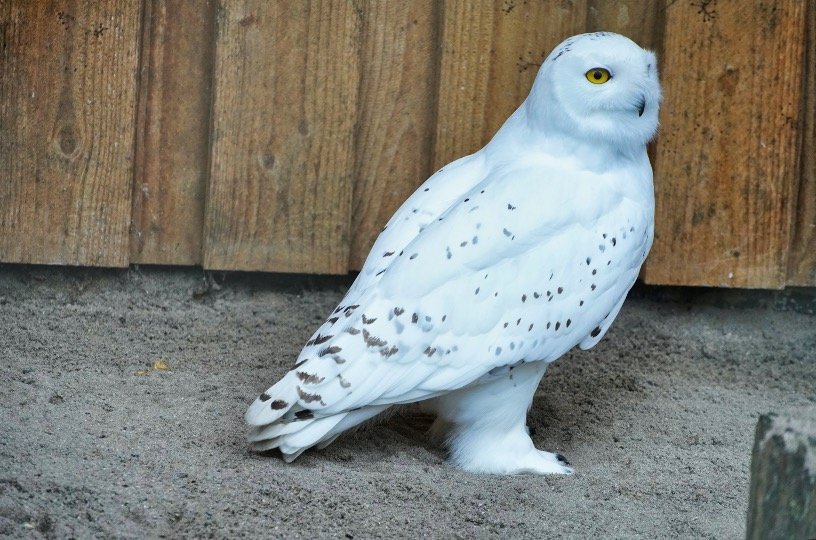
Even against a snowy backdrop, they can be difficult to notice, but they prefer to sit on high ground, which makes them easier to locate. They are normally deafeningly quiet, but during the breeding season they may emit a harsh croak or shrill whistle to attract mates.
Where Do Owls Nest? Everything You Need To Know
Snowy Owls, in contrast to other owls, are diurnal, meaning they hunt in the arctic during the entire 24-hour summer daylight period. They prey on small mammals, primarily lemmings, and can ingest as many as 1600 of them in a single year, according to some estimates.
Listen Snowy Owl Hoot:
Petr Suvorov, XC219348. Accessible at www.xeno-canto.org/219348.
It is also possible to catch flying birds such as ptarmigan and ducks. During the winter, they will prey on rodents, rabbits, squirrels, and birds such as ducks and geese, among other things.
The Snowy Owl’s nest is merely a shallow depression in the tundra that has been scratched out by the animal.
They seek a windswept ridge that will be blown clear of snow, and they keep the nest for many years until discarding it altogether. They lay anything from 3 to 11 white eggs per clutch.
5. The Barred Owl
The Barred Owl can be found in Maryland all year. These large, stocky birds are roughly the size of a crow or a goose.
- Length: 16.9-19.7 in (43-50 cm)
- Weight: 16.6-37.0 oz (470-1050 g)
- Wingspan: 39.0-43.3 in (99-110 cm)

Barred Owls are brown and white in color, with a mottled pattern of vertical stripes on the belly and horizontal stripes on the back and upper chest. They have black eyes, a round head with no ear tufts, and a rounded tail.
Listen Barred Owl Hoot:
Credit: wisconagus, XC691476. Accessible at www.xeno-canto.org/691476.
The Hoohoo call of the Barred Owl is a loud barking hoohoo call. They hunt for small creatures such as squirrels, rabbits, birds, and voles by perching on a high perch and keeping an eye out for their movements.
Baby Owl Sleeping Face Down Is Unbelievable (With Picture)
This species prefers to reside in vast, mature forests, frequently near bodies of water, and lays 1-5 white eggs in tree cavities.
6. Long-eared Owl
The Long-eared Owl can be found throughout the year in Maryland, although after breeding, it may travel further south from the state’s northernmost reaches after breeding. They are medium-sized, slender owls, about the size of a crow, and they have a shocked expression on their faces when they see you.
- Length: 13.8-15.8 in (35-40 cm)
- Weight: 7.8-15.3 oz (220-435 g)
- Wingspan: 35.4-39.4 in (90-100 cm)
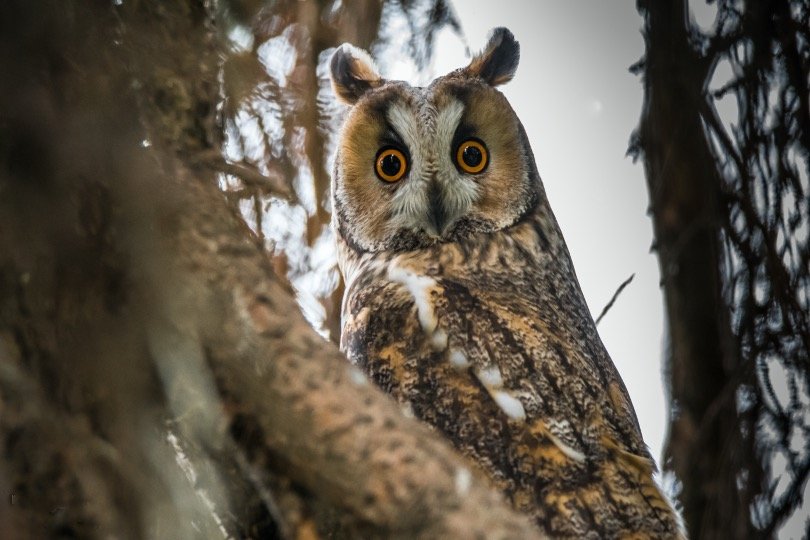
Long-eared Owls have patterned black and brown feathers, buff faces, big black or buff ear tufts, and yellow eyes. Long-eared Owls are found in the northern hemisphere.
Sleeping Owls Are So Adorable: Pictures & Fun Fact
In the evening, they congregate in dense woodlands, where they are effectively concealed, yet close to grassland, where they can forage for food during the day.
Listen Long-eared Owl Hoot:
Credit: András Schmidt, XC699379. Accessible at www.xeno-canto.org/699379.
Among the tiny mammals that Long-eared Owls eat are voles, mice, juvenile rats, and rabbits, among other things. They hunt over broad grassland or pastures by hovering only a few feet above the ground and listening for movement or looking for it with their eyes and ears.
They lay between 2 and 10 white eggs in stick nests that have been abandoned by other animals.
Long-eared Owls are rarely heard, with the exception of during the nesting season. Hoots and whistles at low pitches, as well as shrieks, screams, and meows that sound like cats, are all produced by them.
7. Short-eared Owl
Following breeding, the Short-eared Owl can be located in Maryland throughout the winter months, having migrated from northern states and Canada during the breeding season. They are around the size of a crow and have ear tufts that are relatively little in comparison.
- Length: 13.4-16.9 in (34-43 cm)
- Weight: 7.3-16.8 oz (206-475 g)
- Wingspan: 33.5-40.5 in (85-103 cm)
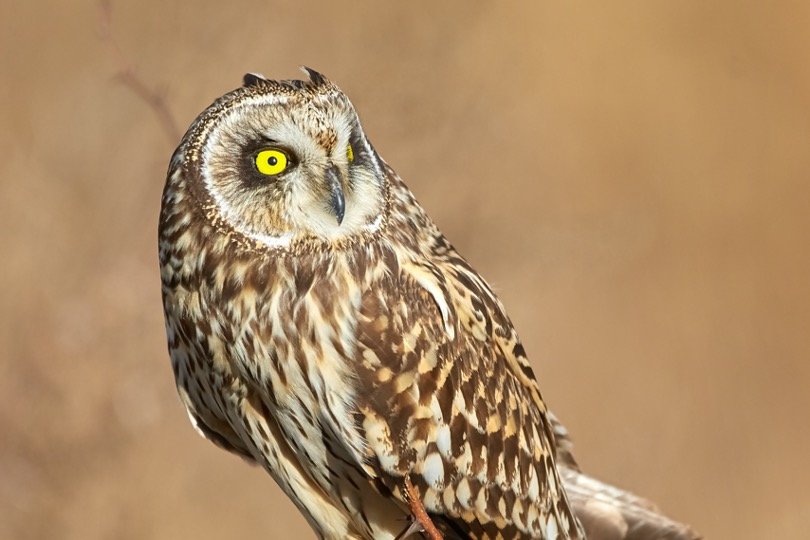
Short-eared Owls have mottled black, brown, and white coloring, a pale face, and yellow eyes with a black rim that are rimmed with black. Their wings are large and rounded, and they have a short tail.
31 Interesting Owls Facts You Don’t Want To Miss
Instead of hunting at night, the Short-eared Owl hunts during the day, primarily at sunrise and sunset. It is their prey, small mammals such as voles and mice, that they are hunting, as they fly low over the ground, seeking for and listening for movement.
Listen Short-eared Owl Hoot:
Credit: Romuald Mikusek, XC669188. Accessible at www.xeno-canto.org/669188.
Short-eared Owls are also one of a kind in that they build their own nests by scraping the ground into a bowl and lining it with grass and soft feathers, which is a first for the species. They lay between one and eleven cream or white eggs per clutch.
They are not extremely noisy, although the males will produce approximately a dozen hoots during courtship, and when protecting the nest, they may bark, whine, or scream. They are nocturnal, but they are active throughout the day.
8. Northern saw-whet Owl
The Northern Saw-whet Owl can be seen in Maryland all year. This tiny owl is roughly the size of a robin.
- Length: 7.1-8.3 in (18-21 cm)
- Weight: 2.3-5.3 oz (65-151 g)
- Wingspan: 16.5-18.9 in (42-48 cm)

Northern-Saw-whet Owls are distinguished by their small bodies and spherical heads. They have a mottled brown body with white spots, a white face with spots, a spotted head with spots, and yellow eyes.
Listen Northern saw-whet Owl Hoot:
Credit: Lance A. M. Benner, XC446701. Accessible at www.xeno-canto.org/446701.
These nocturnal hunters prey on tiny mammals, notably mice, in dense forest environments. It is common for them to construct their nests in tree cavities left by other species, such as Pileated Woodpeckers.
Their eggs are laid directly on the trash rather than on any other type of nesting material used by them. They lay between 4 and 7 white eggs every time they lay an egg.
Owl Legs: Everything You Need To Know (With Pictures)
9. Flammulated Owl
The flammulated owl (Psiloscops flammeolus) is a small migratory North American owl in the family Strigidae. It is the only species placed in the genus Psiloscops.
- Length: 5.9-6.7 in (15-17 cm)
- Weight: 1.5-2.2 oz (43-63 g)
- Wingspan: 15.9-16.1 in (40.5-41 cm)

The flammulated owl is a very small owl, similar in shape to a screech-owl but smaller, with shorter “ear” tufts. The flammulated owl is similar in appearance to the western screech owl, but is only about one-quarter the mass, lacks large ear tufts (but has small ear tufts that are barely visible), and has dark eyes and a different voice.
The Flammulated Owl can be found in the pine trees in Maryland. It looks like a smaller version of the Screech Owl and has smaller ear tufts. You can find it in various habitats, including desert oases and city parks.
With such large wings for a small body, they can fly rapidly from tree to tree. Males and females can be distinguished by their weight. Females are larger, ranging from 62–65 g (2.2–2.3 oz) and males are smaller ranging from 50–52 g (1.8–1.8 oz).
Listen Flammulated Owl Hoot:
Credit: Frank Lambert, XC408147. Accessible at www.xeno-canto.org/408147.
Flammulated Owls are gray, brown, rust, and white, well camouflaged against bark and leaves. They have a reddish form, a grayish form, and some intermediate plumages, as some screech-owls do.
Flammulated Owls roost by day and hunt flying insects by night in the canopy of mature trees and understory. They locate prey visually and capture them in quick sallies from a perch.
The flammulated owl nests in tree cavities and has two to four young at a time after a 26-day incubation period. The young are able to forage for their own prey after about 25–32 days.
10. Burrowing Owl
The burrowing owl (Athene cunicularia), also called the Shoco, is a small, long-legged owl found throughout open landscapes of North and South America.
Maryland’s open country habitats and beaches attract the Burrowing Owl. This owl was once called the Howdy Bird by cowboys because it nods its head while it’s perching near its burrow.
- Length: 7.5-9.8 in (19-25 cm)
- Weight: 5.3 oz (150 g)
- Wingspan: 21.6 in (55 cm)
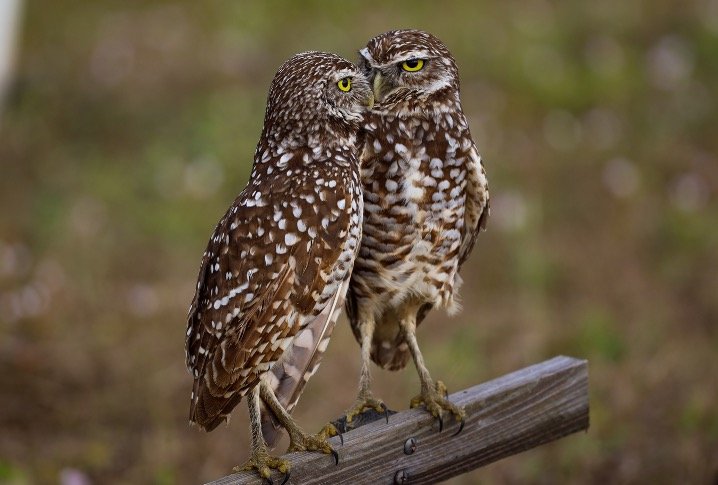
Burrowing owls have bright eyes; their beaks can be dark yellow or gray depending on the subspecies. They lack ear tufts and have a flattened facial disc.
The owls have prominent white eyebrows and a white “chin” patch which they expand and display during certain behaviors, such as a bobbing of the head when agitated. Adults are brown birds mottled with sandy-pale spots on the upperparts.
The breast is spotted, grading to dark brown bars on the belly. They have a bold white throat and eyebrows, and yellow eyes. The brown juveniles are less mottled than adults, with buffy-yellow underparts and wing patch.
Listen Burrowing Owl Hoot:
Credit: David Ricardo Rodríguez-Villamil, XC524491. Accessible at www.xeno-canto.org/524491.
Burrowing Owls spend most of their time on the ground or on low perches such as fence posts. They hunt close to the ground catching insects and small animals. When alarmed they jerk their bodies quickly up and down.
They are active during the day. Unlike other owls that nest on trees and cavities, the Burrowing Owl prefers to nest in burrows excavated by the prairie dog.
It also takes the burrows of ground squirrels and tortoises. It’s pretty rare to see in Maryland, and its perfect camouflage makes it more difficult to find.

